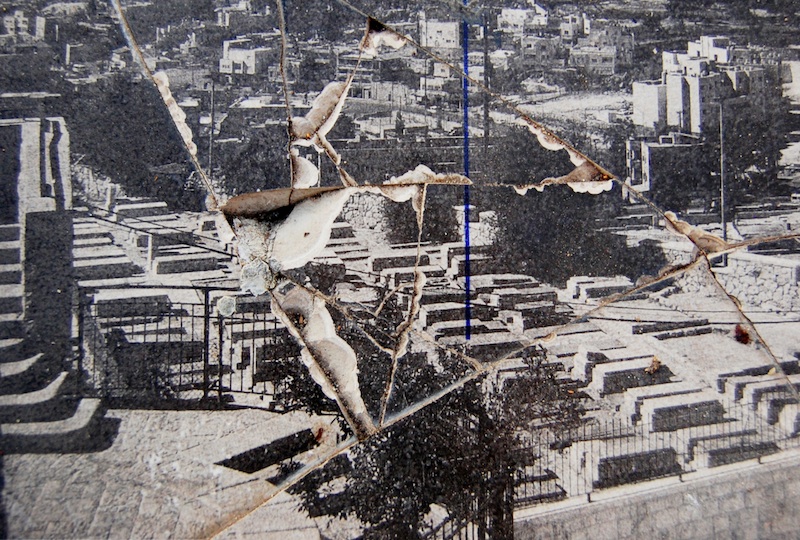Cornelia Parker came to prominence with various acts of destruction/resurrection. Some of the most famous examples include a blown-up garden shed in Cold Dark Matter: An Exploded View, 1991, the charred remains of churches in Mass (Colder Darker Matter),1997 and Anti-Mass, 2005, and pearls fired through a shotgun in Suit, Shot by a Pearl Necklace, 1995. But within the ambiguity of creation by destruction, there is also the artist as archeologist.
These angular pieces of urban archeology are hovering above the ground as if frozen in space
In Subconscious of a Monument, 2005, shown at the Royal Institution of British Architects, fragments of dry clay were suspended from the ceiling as a kind of flying carpet. The soil had been excavated from underneath the Leaning Tower of Pisa to prevent it toppling over. The “subconscious” of the iconic tower was recycled into Parker’s installation about iconography, defiance of gravity, and concern about our relationship with time and space.
These recurring themes in Parker’s work clearly continue in her current exhibition at the Frith Street Gallery. As we enter, we face a collection of damaged wooden planks, carefully arranged in casual disorder, as if just left behind, or as something not quite finished. On closer inspection we can see how each plank has its own history, wounds, even personality.
As it is often the case with Parker’s installations, elements of nature appear to defy the elemental law of nature: gravity. In the Subconscious of a Monument, fragments of earth levitate; here it’s a sculpture of wooden planks which are suspended mid-air. The difference, perhaps a significant one, is the interrelationship of the floating elements of nature. The clay fragments had a life of their own: although all of them were attached to the ceiling, each led an existence detached from the rest. Here the planks, leaning against one another, create a supportive, coherent system: each has a role to play and one cannot be without the other.
 The piece is called Unsettled, and the damaged planks could have been from any urban area around the world. But these ones, in such a heightened state of precarious co-existence, are from the streets of old Jerusalem. Does it matter where Parker collected them? Not really: the image of fragile interconnectedness speaks for itself. On the other hand, the contextual shift sharpens a sense of co-existence-on-edge. (Pictured above: Broken View (Mount of Olives, Jerusalem) 2012; digital print.)
The piece is called Unsettled, and the damaged planks could have been from any urban area around the world. But these ones, in such a heightened state of precarious co-existence, are from the streets of old Jerusalem. Does it matter where Parker collected them? Not really: the image of fragile interconnectedness speaks for itself. On the other hand, the contextual shift sharpens a sense of co-existence-on-edge. (Pictured above: Broken View (Mount of Olives, Jerusalem) 2012; digital print.)
The minimalist sparseness of the gallery space is interrupted by irregular, flat grids (main picture). Parker, the street archeologist, digs into the cracks of the pavement, samples the ground under our feet, immortalises the shapes and patterns by pouring liquid cold-cure rubber into the gaps, letting it set, and capturing them in black bronze. These angular pieces of urban archeology are hovering above the ground as if frozen in space. Just like the battered planks, they claim a fragile existence. Yet the excavated/resurrected cracks in the pavement are sturdy enough to cause serious destruction were you to be misled by their line-drawing-like flimsy appearance, and bump into them.










![SEX MONEY RACE RELIGION [2016] by Gilbert and George. Installation shot of Gilbert & George 21ST CENTURY PICTURES Hayward Gallery](/sites/default/files/styles/thumbnail_125_x_125_/public/mastimages/Gilbert%20%26%20George_%2021ST%20CENTURY%20PICTURES.%20SEX%20MONEY%20RACE%20RELIGION%20%5B2016%5D.%20Photo_%20Mark%20Blower.%20Courtesy%20of%20the%20Gilbert%20%26%20George%20and%20the%20Hayward%20Gallery._0.jpg?itok=3oW-Y84i)




Add comment